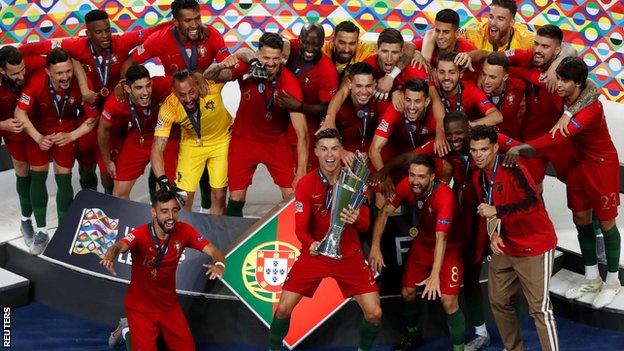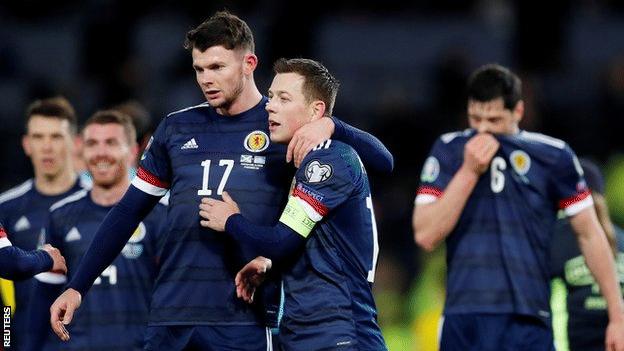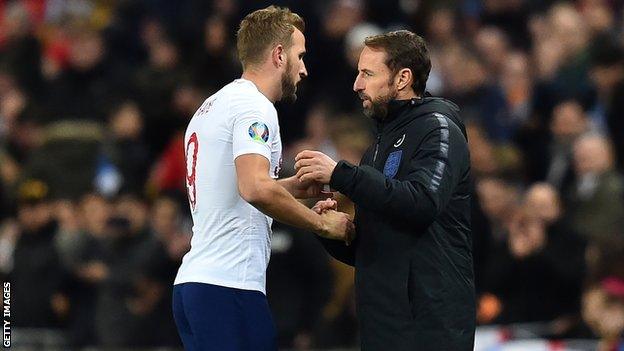Nations League: Everything you need to know about Tuesday's draw
- Published

Portugal are the reigning Nations League champions
The 2020-21 Nations League draw takes place on Tuesday at 17:00 GMT in Amsterdam, with the home nations waiting to discover their opponents.
There have been several changes from the inaugural 2018-19 event, which Portugal won last summer.
There will now be four teams in each group in the top three divisions - compared to mostly three last time.
It does not offer any guaranteed 2022 World Cup places, whereas the previous version provided four Euro 2020 spots.
Two teams could still qualify for Qatar via this route, though, as two of the 12 World Cup play-off places (for three spots) are available via the Nations League, compared to all 16 play-off teams for the Euros (more on this below).
England are in the top tier, with Scotland, Wales, Northern Ireland and the Republic of Ireland in the second of four divisions.
The games run from September to November 2020, with the finals next summer.
What happened in the last Nations League?

Scotland won their group in League C to win promotion and a Euro 2020 play-off place
The Nations League was split into four divisions based on countries' Uefa national team coefficients. Each country was drawn in a group of three or four teams, playing everyone home and away.
The winners of each of the top league's groups met in a finals tournament in 2019, which hosts Portugal won, beating the Netherlands 1-0. England finished third after beating Switzerland on penalties.
The team who finished top of each group in every division were guaranteed a Euro 2020 play-off place - with the next best finisher getting a spot instead if that team had already made it via the traditional qualifying campaign.
Those play-offs - with Scotland, Northern Ireland and the Republic of Ireland all involved - take place later this month, on 26 and 31 March. There are 16 teams in the play-offs in four groups, with a semi-final and final - with four teams going to this summer's tournament.
Also, each team who won the group was promoted to the higher league, with countries finishing bottom - including Germany from League A and Northern Ireland and the Republic of Ireland from League B being relegated.
What has changed in the new one?

Can England go one step further this time?
Uefa increased the size of the top three tiers to 16 countries - meaning each group will have four teams - and decreased the size of the bottom tier to seven.
With the higher tiers having three teams per group in the 2018-19 edition, it meant one team had to play a friendly on each matchday - even though one point of the Nations League was to eliminate 'meaningless' friendlies.
This season's reshuffle means none of the 12 countries relegated will actually have to drop divisions.
The teams who win each group in the top division - as England did last time - will go into the finals tournament in June 2021. The teams who finish bottom will be relegated to League B.
Any team which finishes top of their group in Leagues B, C or D will be promoted. The teams who finish bottom of League B groups will be relegated, while there will be a play-off to decide which League C bottom teams are relegated because League D only has two groups.
But unlike the previous campaign when everybody was qualifying for the Euro 2020 play-offs, only two World Cup play-off spots will be available for any of the 55 countries.
The best two Nations League group winners who do not qualify for the World Cup or play-offs through normal qualifying will go into the 12-team World Cup play-offs in March 2022.
The top teams from each of Europe's 10 World Cup qualifying groups - games run from March to November 2021 - qualify automatically for the tournament in Qatar. The 10 runners-up will join the two Nations League teams, with three of those going to the World Cup.
Who can draw who?
Teams are separated into leagues - and then pots - depending on where they finished in last season's Nations League.
So England - in pot one of League A - will face a team from each of pot two, pot three and pot four in the top division. Wales, Scotland and Northern Ireland could end up in one League B group.
The draw should be straightforward because of the way the leagues and pots have happened. There are no instances where teams who need to be kept apart - which sometimes happens for political or other reasons - can be drawn against each other.
League A
Pot 1: Portugal, Netherlands, England, Switzerland
Pot 2: Belgium, France, Spain, Italy
Pot 3: Bosnia-Herzegovina, Ukraine, Denmark, Sweden
Pot 4: Croatia, Poland, Germany, Iceland
League B
Pot 1: Russia, Austria, Wales, Czech Republic
Pot 2: Scotland, Norway, Serbia, Finland
Pot 3: Slovakia, Turkey, Republic of Ireland, Northern Ireland
Pot 4: Bulgaria, Israel, Hungary, Romania
League C
Pot 1: Greece, Albania, Montenegro, Georgia
Pot 2: North Macedonia, Kosovo, Belarus, Cyprus
Pot 3: Estonia, Slovenia, Lithuania, Luxembourg
Pot 4: Armenia, Azerbaijan, Kazakhstan, Moldova
League D
Pot 1: Gibraltar, Faroe Islands, Latvia, Liechtenstein
Pot 2: Andorra, Malta, San Marino
When are the games?
Matchday 1: 3-5 September 2020
Matchday 2: 6-8 September 2020
Matchday 3: 8-10 October 2020
Matchday 4: 11-13 October 2020
Matchday 5: 12-14 November 2020
Matchday 6: 15-17 November 2020
Finals: 2, 3, 6 June 2021
League C relegation and World Cup 2022 play-offs: 24, 25, 28, 29 March 2022*
*in the unlikely event one of the teams who finish bottom in a League C group also qualify for the World Cup play-offs, the relegation play-offs will be cancelled and the two teams with the fewest points relegated instead